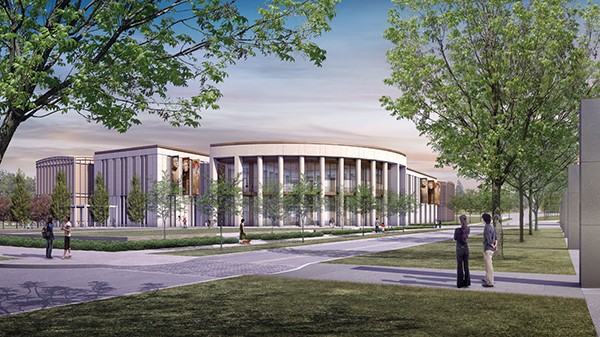A new $160 million Tennessee State Museum will open in 2018 at Nashville’s Bicentennial Mall. The 137,000-square-foot facility will house artifacts from across the state, and each city will get its own chronological exhibit.
The museum broke ground earlier this month, and now its staff is on a statewide tour to inform residents of Tennessee towns and cities of the museum’s progress. The tour stopped in Memphis earlier this week
The Flyer spoke with the museum’s community officer Mary Skinner and Chief Curator Dan E. Pomeroy about the hurdles of the expansive project and what sort of representation Memphis will have. — Joshua Cannon

Flyer: When outsiders think of Memphis, they often think of Elvis and barbecue. How will the museum break that cliché in what’s represented about the city?
Mary Skinner: The State Museum traces the roots of its large collection back to 1818 and has been collecting artifacts pertinent to the telling of Tennessee’s history for almost 200 years.
We literally have hundreds of objects (furniture, art, textiles, musical items) from Memphis in our collection, including a 1919 American LaFrance Type 45 triple-combination fire engine, an 1860s Rococo Revival mirror from the Hunt Phelan House, a collection of Ernest Withers’ civil rights photographs, a document signed by Abraham Lincoln concerning Civil War government in Memphis, and paintings by Carroll Cloar. The list goes on and on.
How is the museum determining what to fit and what to leave out?
MS: It is impossible for any museum with a collection as large as ours to put everything on exhibit for public view at one time. That is why the new museum will have separate galleries that will allow visitors to explore specific periods and themes more deeply — including our Civil War history, music, art and cultural issues of the day. These exhibits will be easier to change and update as we continue to acquire new artifacts.
How do you tell a state’s long and varied story through artifacts?
Dan Pomeroy: In order to be prepared to tell this full story, the State Museum has been aggressively and selectively adding to its collection of objects and artifacts for the last four decades.
This collection contains artifacts relating to notable personalities, such as presidents and governors, but also includes items designed to tell the story of other aspects of Tennessee, such as Native Americans, urban centers, business, manufacturing, labor, immigration, African Americans, art, crafts, music, children, home life, rural communities, women, sports, and common soldiers. These and other stories obviously intersect and are interwoven, which is part of the challenge to museum interpretation.
What do you think visitors will take away about Tennessee?
DP: The ultimate goal is to create as complete a story as possible for the people of Tennessee and for our state’s visitors. Tennessee’s story is a critical and significant part of America and the world, and, taken as a whole, it should be a source of pride and empowerment to Tennesseans everywhere. This may be particularly important for the tens of thousands of school children who will visit the State Museum.

